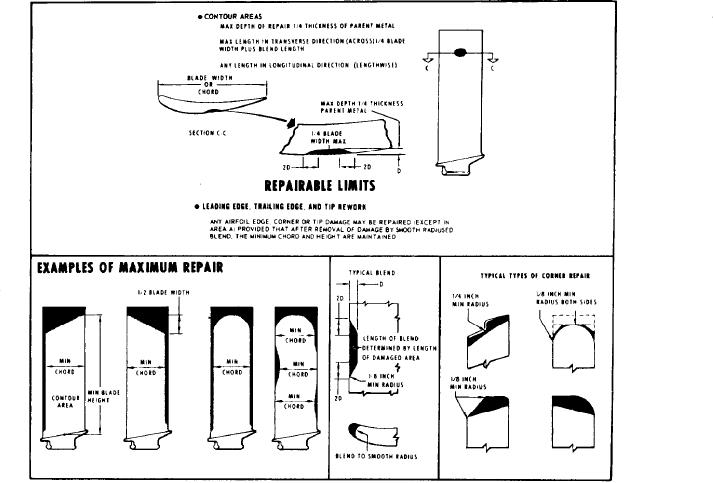
emery cloth. Use a medium stone for areas
in the MIM. Figure 10-4 illustrates representative
containing small nicks and dents.
repairable limits. Figure 10-5 shows examples of
blade repairs.
Use fine emery cloth and/or a fine abrasive
stone to polish the reworked area. Polish until the
When working on the inner half of the air-
finish looks and feels like the original. If two
foil, you should treat damage with extreme
blended areas overlap to form a sharp point or
caution. Make no attempt to remove damage by
ridge, blend out the point or ridge. Blend the
straightening. Inspect repaired compressor blades
contour surfaces with a medium stone and finish
by dye check, magnetic particle inspection, or
with emery cloth and/or a fine abrasive stone. The
by fluorescent penetrant inspection methods.
finished repair should be as much like the original
Remove all traces of the damage. All surfaces
must be smooth. All repairs must be well blended.
finish as possible.
No cracks of any extent are tolerated in any area.
Front compressor blades that require replace-
Bowed or bent blades are not reused. If gauges
ment are replaced by blades having the same
are not available, the repaired blades are aligned
moment balance code. The moment balance codes
and compared with a new blade of the same stage.
are marked on the front face of the root of the
blade. At the original buildup of the compressor
Use a smooth file when removal of con-
rotor discs and blades, a set of blades coded
siderable amounts of material is necessary. File
according to individual moment were installed.
or blend at right angles to the width of the blade.
The installation on the disc minimizes the static
When you cannot reach the damaged area with
imbalance due to variations in the blade moment.
a file, use course emery cloth. Use a medium stone
The blades are numbered in clockwise sequence,
on areas that have been reworked with a file or
Figure 10-4.-Repairable limits and examples of maximum repair.
10-8

